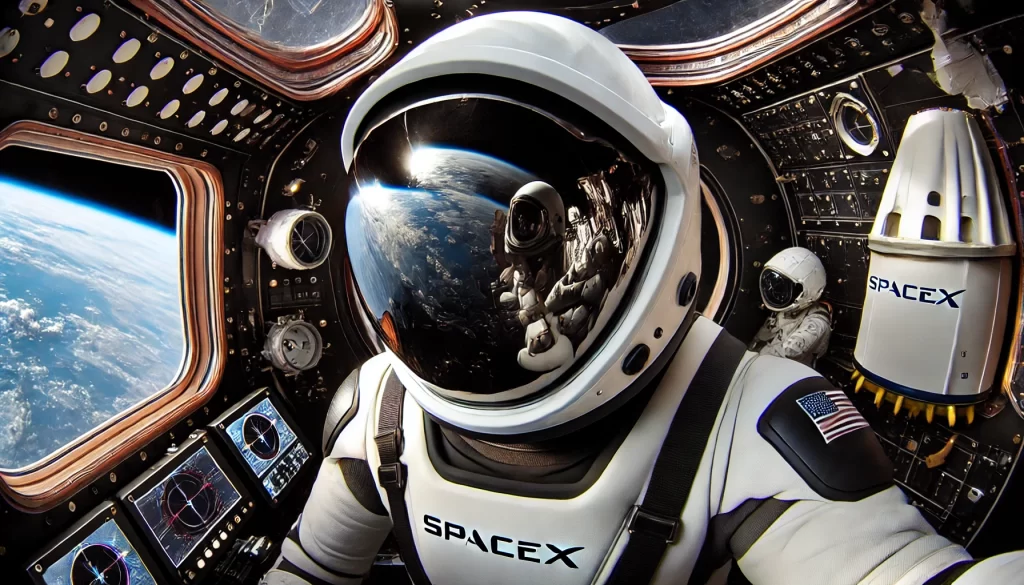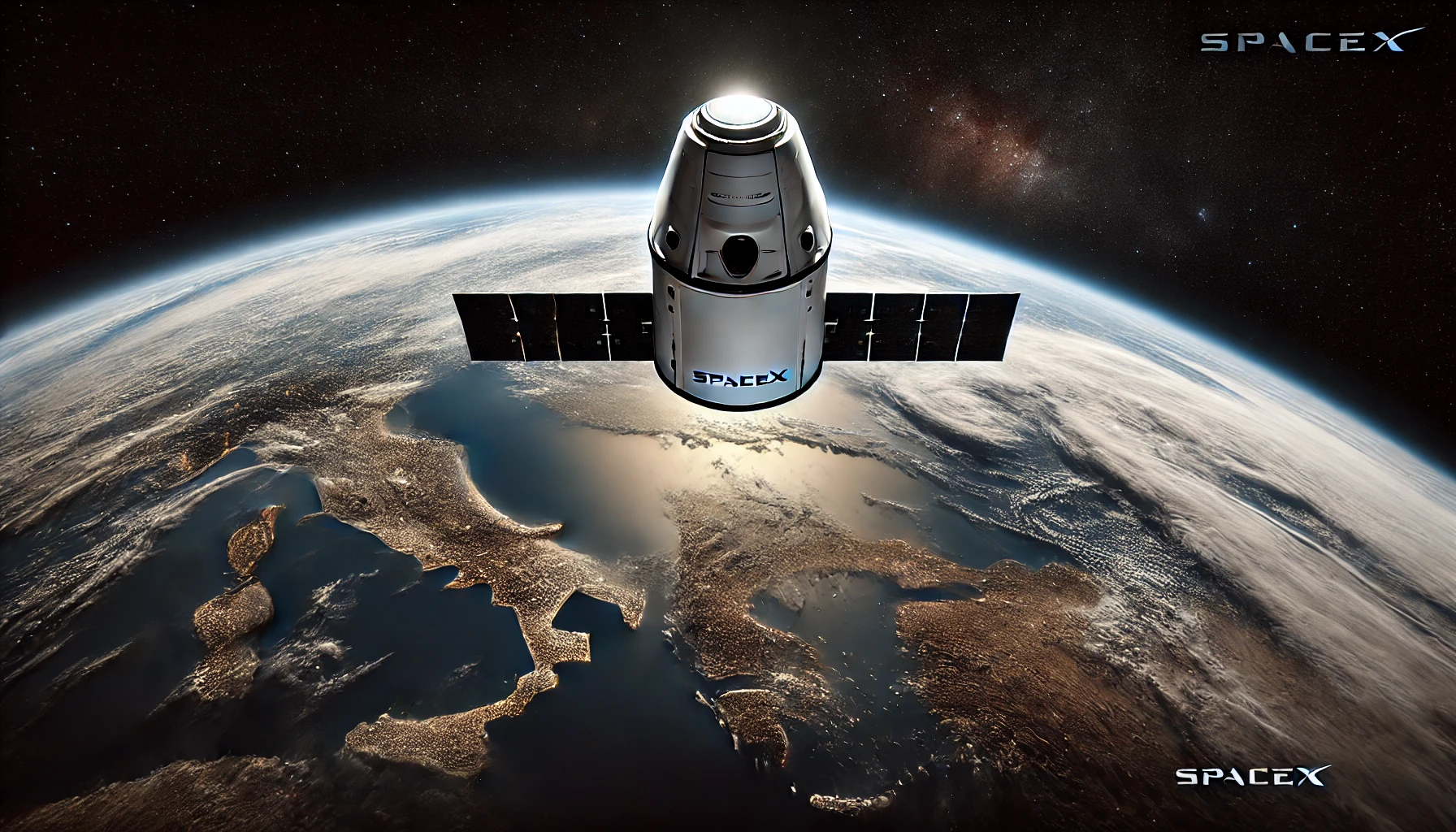On September 12, 2024, SpaceX and the Polaris Dawn mission made history by conducting the first-ever private spacewalk. This milestone was achieved during a five-day spaceflight led by Jared Isaacman, a billionaire entrepreneur and the commander of Polaris Dawn, who partnered with SpaceX to push the boundaries of commercial space exploration. The mission represents a crucial step toward advancing human spaceflight, with SpaceX aiming to develop technologies that could one day facilitate human travel to Mars and other planets.
A Private Spacewalk with a Big Purpose
The spacewalk, which took place at an altitude of over 740 kilometers (about 460 miles) above Earth, was designed to test new spacesuit technology developed by SpaceX. Unlike previous spacewalks conducted by government astronauts from agencies like NASA, this was a fully commercial operation. Both Isaacman and Sarah Gillis, a SpaceX engineer, ventured outside the SpaceX Dragon capsule to assess the suits’ performance in the vacuum of space.
Isaacman was the first to step outside, tethered to the spacecraft by a 3.6-meter (12-foot) long umbilical cord that provided oxygen and power. He tested the suit’s mobility by performing a series of movements while gripping a railing attached to the Dragon capsule. “Back at home, we all have a lot of work to do. But from here, Earth sure looks like a perfect world,” Isaacman commented during his time outside the spacecraft.
After about 10 minutes, Gillis took her turn. She followed a similar routine, stepping partway out of the capsule and performing mobility tests. Gillis also inspected the hatch seal and noted some minor bulging around the edges, which she fixed before re-entering the capsule. Both astronauts spent less than two hours in total outside the spacecraft, a stark contrast to the longer, more complex spacewalks conducted by NASA, which can last up to eight hours.
Pushing Technological Boundaries
The primary objective of the Polaris Dawn mission was to test the next generation of extravehicular activity (EVA) spacesuits, which will be critical for future missions, including potential efforts to establish human settlements on Mars. The black-and-white suits tested during the spacewalk are an evolution of the suits previously used by astronauts working inside spacecraft, but with key upgrades. These include flexible joints for improved mobility, thermal controls for comfort, and a helmet with a digital heads-up display.

The spacesuits are designed to provide better protection and flexibility for astronauts working outside spacecraft or on planetary surfaces. Chris Trigg, SpaceX’s senior manager of spacesuits, explained the goal: “The ultimate goal is that you can put on the space suit and go out and get work done anywhere in the solar system and not feel like you’re wearing anything more than you normally wear every day.”
In addition to testing spacesuits, the mission involved other scientific experiments. The four astronauts onboard the Dragon capsule were conducting around 40 experiments, many of which were focused on how weightlessness and cosmic radiation affect the human body. For example, they performed magnetic resonance imaging (MRI) scans of their brains to study the effects of space travel on the central nervous system.
The Bigger Picture
Polaris Dawn is the first of three planned missions that aim to push the limits of human space exploration. The ultimate goal of these missions is to develop the technologies needed for off-world exploration, particularly Mars colonization, a key ambition of SpaceX founder Elon Musk. The next mission could include an even more ambitious task: Isaacman has suggested the possibility of sending a crew to perform repairs on NASA’s aging Hubble Space Telescope.
While the spacewalk was relatively short and less complex than those conducted by professional astronauts, it is a significant milestone for the commercial space industry. NASA Administrator Bill Nelson celebrated the achievement, stating, “Today’s success represents a giant leap forward for the commercial space industry and NASA’s long-term goal to build a vibrant U.S. space economy.”
A New Era of Space Travel
The Polaris Dawn mission symbolizes the increasing role of private companies in space exploration. In 2021, Isaacman also led the first fully civilian mission to orbit Earth, known as Inspiration4. That mission, which raised money for St. Jude Children’s Research Hospital, set the stage for the more ambitious Polaris Dawn flight.
With private individuals now participating in spacewalks and testing new technologies, the space industry is moving beyond the exclusive domain of government agencies like NASA and Roscosmos. This shift opens the door to more private ventures and could lead to further advances in human spaceflight.
This article is based on the following articles:
https://apnews.com/article/spacex-spacewalk-private-polaris-dawn-87d4c78853f0249baf29631bedfac749
https://www.nytimes.com/2024/09/11/science/spacex-polaris-dawn-astronauts-spacewalk.html

Background Information
1. What is Space Exploration?
Space exploration refers to the study and exploration of outer space using technology like spacecraft, satellites, and space stations. Since humans can’t survive in space without special equipment, space exploration involves sending astronauts in specially designed spacecraft to explore regions beyond Earth. The first successful space exploration mission happened in 1957 when the Soviet Union launched Sputnik 1, the first artificial satellite. Soon after, humans began traveling to space, with the Soviet cosmonaut Yuri Gagarin being the first person to orbit Earth in 1961.
2. What is a Spacewalk?
A spacewalk, or extravehicular activity (EVA), is when an astronaut leaves their spacecraft to work in the vacuum of space. This is one of the most dangerous tasks astronauts can perform because they are exposed to the harsh conditions of space, including a lack of air, extreme temperatures, and the risk of being hit by space debris. During a spacewalk, astronauts wear specially designed suits that protect them and provide the necessary life support systems. Spacewalks are often used to repair equipment on spacecraft or space stations, conduct scientific experiments, or test new technology.
The first-ever spacewalk was performed by Soviet cosmonaut Alexei Leonov in 1965 during the Voskhod 2 mission. The United States soon followed with astronaut Ed White’s spacewalk during the Gemini 4 mission.
3. The Role of NASA and Government Space Agencies
For decades, space exploration was primarily led by government agencies like NASA (National Aeronautics and Space Administration) in the United States and Roscosmos in Russia. These agencies are responsible for sending astronauts to space, conducting scientific research, and developing the technology needed for space travel. NASA’s most famous achievements include landing the first humans on the moon in 1969 during the Apollo 11 mission, as well as operating the Space Shuttle program, which allowed astronauts to travel to space and return to Earth aboard reusable spacecraft.
Government space agencies have also collaborated to build the International Space Station (ISS), where astronauts from around the world live and work in space. Since 2000, the ISS has served as a laboratory for scientific research and technological advancements in space.
4. The Rise of Private Space Companies
In recent years, private companies have entered the space industry. One of the most well-known of these companies is SpaceX, founded by Elon Musk in 2002. SpaceX was created to reduce the cost of space travel and eventually enable humans to live on other planets, such as Mars. Unlike government agencies that rely on taxpayer funding, private companies like SpaceX are funded by private investments and commercial contracts.
SpaceX has achieved many firsts in space exploration. In 2012, it became the first private company to send a spacecraft to the ISS. In 2020, SpaceX successfully launched astronauts into orbit on the Crew Dragon spacecraft, making it the first private company to send humans into space. The company’s long-term vision includes sending humans to Mars and beyond.
5. Why Spacesuits Are Important
Spacesuits are essential for keeping astronauts alive and safe in space. The vacuum of space has no air to breathe, and temperatures can swing dramatically between freezing cold and scorching hot depending on whether the astronaut is in the sunlight or shadow. Additionally, space is full of dangerous radiation from the sun, and there’s always a risk of being hit by tiny pieces of space debris.
Spacesuits provide astronauts with air to breathe, protect them from temperature extremes, and shield them from radiation. They also maintain the pressure around the astronaut’s body, preventing harmful effects on their organs. Modern spacesuits come with built-in life support systems, which include oxygen tanks, water to drink, and communication equipment that allows astronauts to talk to each other and mission control.
6. Why SpaceX is Testing New Spacesuits
As SpaceX plans for future missions to the moon, Mars, and other destinations in space, it’s important for them to develop more advanced spacesuits. Spacesuits used inside spacecraft or space stations are designed for relatively short periods of use in controlled environments. However, future missions will involve astronauts spending long periods outside on planets or moons, where they will need more flexible, durable, and self-sufficient spacesuits.
Testing spacesuits during missions like Polaris Dawn helps SpaceX gather valuable data on how these suits perform in space. This will be important as the company continues to improve spacesuits for future space missions, where astronauts might be required to walk on the surface of Mars or repair spacecraft during long journeys.
7. Why Mars and Space Colonization Matter
One of SpaceX’s long-term goals is to make humans a “multi-planetary species” by establishing colonies on Mars. Space colonization refers to the idea of humans living and working on planets or moons other than Earth. The idea behind colonization is that by spreading human life to other planets, we reduce the risk of humanity being wiped out by events like natural disasters or asteroid impacts.
Mars is considered a good candidate for colonization because it is relatively close to Earth, and it has water in the form of ice. However, there are many challenges to living on Mars, including its thin atmosphere, cold temperatures, and lack of oxygen. SpaceX is working to develop the technology needed to overcome these challenges, including spacecraft, habitats, and spacesuits.
8. How Spacewalks Are Conducted
In order to conduct a spacewalk, astronauts follow a strict set of procedures. Before leaving their spacecraft, they go through something called a “prebreathe protocol,” where they breathe pure oxygen for a period of time. This reduces the amount of nitrogen in their bloodstream, preventing a dangerous condition called decompression sickness, or “the bends.” Decompression sickness happens when nitrogen bubbles form in the blood due to a rapid change in pressure, similar to what happens to deep-sea divers who come to the surface too quickly.
Because of the risks involved, spacewalks are carefully planned and practiced. Astronauts undergo extensive training on Earth in environments like giant swimming pools that simulate the weightlessness of space. While outside the spacecraft, they remain tethered to it to prevent floating away. They also have to work quickly but carefully to avoid running out of oxygen or other resources.
9. The Future of Space Travel
The success of missions like Polaris Dawn demonstrates that space exploration is no longer limited to professional astronauts working for government space agencies. Increasingly, private individuals and companies are participating in space missions, which could lead to more discoveries and advancements in technology.
As companies like SpaceX continue to push the boundaries of what is possible, we may soon see more private space missions, space tourists, and even the first human settlements on other planets. This new era of space exploration is likely to involve not only astronauts but also scientists, engineers, and even regular people who dream of going to space.

Debate/Essay Questions
- Is the colonization of Mars or other planets a realistic and necessary goal for humanity’s survival, or is it an impractical dream that distracts from more urgent planetary issues?
Please subscribe to Insight Fortnight, our biweekly newsletter!
